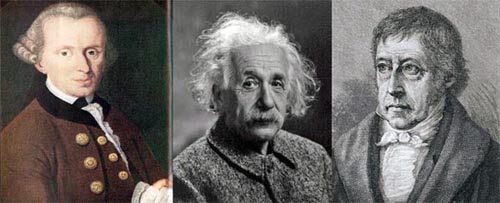T. D. Lee's Rome
-
There are many conferences in Italy. Even though they are not held in Rome, we usually
spend one or two do-nothing days there. We learn history lessons while
doing nothing. You are invited to my
- Rome page. I add new photos whenever I come back from Rome, and this process seems to be endless. Indeed, Rome is an eternal city.
- Where is TD's Galileo statue?
- Piazza della Repubblica is one block west of the Termini.
Like all Roman plazas, this area is centered around a fountain, and
surrounded by buildings of historical significance.
- On the west side of the fountain,
there are two circularly curved buildings. The narrow separation leads to via
Nazionale leading to the monument of Victor Emanuel II. Those buildings
thus could have been used for government offices in the past. These days,
they are mostly for luxury hotels, like this.
- On the east side, there is a church built into the Roman bath house.
- On the west side of the fountain,
there are two circularly curved buildings. The narrow separation leads to via
Nazionale leading to the monument of Victor Emanuel II. Those buildings
thus could have been used for government offices in the past. These days,
they are mostly for luxury hotels, like this.
- Basilica Santa Maria degeli Angeli e dei Martiri is built into the Roman
bath house on the eastern ring of the Piazza Repubblica. This church has
its history.
This bath house, constructed by Emperor Caracalla (211-2173), was capable of accommodating 5,000 people simultaneously. It was a great gathering place for those Roman citizens. Perhaps, it was like a resort beach.
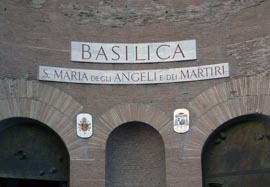
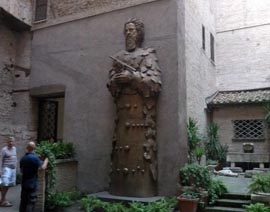
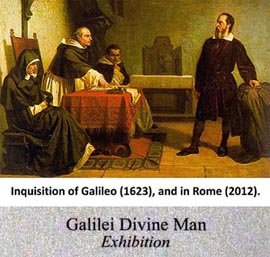
- Entrance to the Basilica carved into the Roman wall (from the ruins of the Roman bath house).
- Inside the Basilica (from the public domain).
- Main altar of the Basilica.
- One of the side altars.
- The church organ next to an elegant painting.
- Model of Galileo's pendulum in the Basilica.
- Statue of Galileo in the backyard.
This statue was designed by Tsung-Dao Lee of Columbia University. He
shared the 1957 Nobel prize in physics with C. N. Yang. TD was 30 years old then.
- In 1623, Galileo was found guilty
for his theory not consistent with the church doctrine. He is now called
a "Divine Man" in this church.
The Galileo story has been inspirational to me from my childhood. I received two death sentences (ordering me not to do physics) in the past. I received my first death sentence in 1966 for publishing a paper not consistent with the physics establishments at that time. Click here for a detailed story.
I received my second death sentence in 1983. I am not ready to tell the full story yet, but I may in the future. The point is that all those who punished me are now gone from the physics. - The construction of this Galileo statue was apparently financed by the Chinese Academy of Sciences.
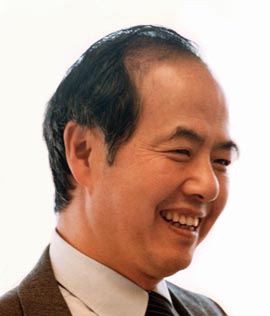
|
| photo from the Wikipedia. |
| |
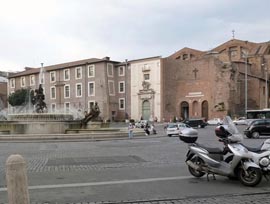
|
In September of 2012, I spent one week in Rome to attend a conference held at the Engineering Faculty of the Univ. of Rome Sapienza near the Colosseum. This gave me an excellent opportunity to take many photos of historical significance. Go to my Rome page for new additions.
However, you will not be impressed with those standard photos. The purpose of this webpage is to show you a statue of Galileo Galilei designed by a physicist named Tsung Dao Lee of Columbia University. He shared the 1957 Nobel prize in physics with C. N. Yang on their work on parity violation. T. D. Lee was only 30 years old then. Did you know he was also an artist?
Basiliaca di San Pietro in Vincoli (Saint Peter in Chains)
is another minor church in Rome. This church is adjacent to the Engineering Faculty of the University of Rome, and is very close to the Roman Colosseum. Let us look at some photos first.- Church Building. This building does not
look like many elegant-looking churches in Rome.
- Entrance to the Church. Tourists come to this church.
- The Church sign Basiliaca di Pietro in Vincoli.
- Inside the Church, as elegant as any other Catholic churches in the world.
- There are two important items of in this church. Michelangelo and
Kant!
- Michelangelo's Moses. There are many
statue of Moses in the world, but Michelangelo's statue is special. Here
is another photo of the same statue.
You may compare Michelangelo's imagination with
that of a modern artist.
This is a bust of Moses at the entrance lobby of the Earl Hall (for
student activities) of Columbia University.
-
Nicholas
of Cusa (1401–1464) was a German philosopher, theologian,
jurist, mathematician, and astronomer, according to Wikipedia.
His remains were entombed in this church. I was very happy to have a photo of myself in front of his tomb (September 2012).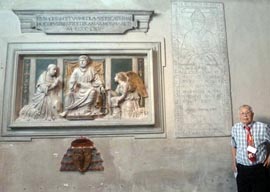
- As a theologian, Nocolas Cusa did not insist on his own
interpretation of God.
Instead, he proposed a theory that one has to develop his/her "divine"
mind to understand God. Since different people can develop different
ways of understanding God depending on their backgrounds, Cusa's
philosophy was a prelude to Kantianism. In fact, during the 19th
century, many Kantian scholars studied Cusa's writings.
For developing this theory Nicholas Cusa had some conflicts with the church, but was wise enough to avoid inquisition. He was born 323 years before Immanuel Kant (1724-1804), but he developed this Kantian way of thinking within the framework of theology. The question is whether Kant copied Cusa's idea. Let us assume that he did not.
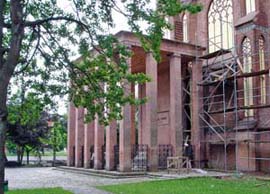
- Kant was a devoted non-Christian, and does not mention God
in any of his writings. This the reason why he remains are
not inside the Cathedral of Koenigsberg. Here is
a photo of Kant's grave
outside the Cathedral. I was
there in 2005.
For theologians, God is Kant's Ding-an-Sich. Thus, God appears differently for those with different backgrounds. However, the church did not allow open discussions of this issue. This trend continued until the period of Soren Kierkegaad (1813-1955).
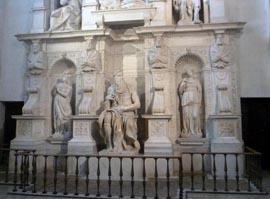
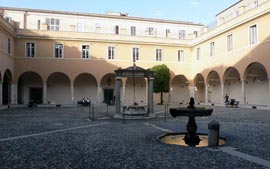
- Michelangelo's Moses. There are many
statue of Moses in the world, but Michelangelo's statue is special. Here
is another photo of the same statue.
You may compare Michelangelo's imagination with
that of a modern artist.
This is a bust of Moses at the entrance lobby of the Earl Hall (for
student activities) of Columbia University.
- The Engineering Faculty of the University of Rome is housed in a
building next to this church. This was originally built as a monastery
but became a branch of the University of Rome after World War I. A
very charming place indeed.
- Entrance to the Engineering Building of the University of Rome.
- Quadrangle of the Engineering building.
- I become very happy whenever I have a photo with students. Here is another photo.
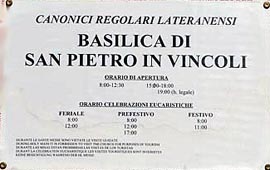
|
History of Physics
- Since Galileo Galilei started the history of physics, and Italians take the
this aspect very seriously. I was fortunate enough to be invited to the
conference entitled "32nd Congress of the Italian Society of Historians of
Physics and Astronomy (September 2012).
- What did I talk about? There are many published articles about Kant's
influence on Einstein. However, Kantianism, with its Ding an-Sich, cannot
accommodate Einstein's relativity. I talked about how Einstein's theory
leads to Hegel's philosophy which he derived from his historical observations.
Thus, Einstein defines how to approach the history of physics.
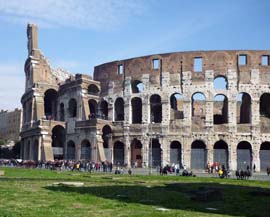

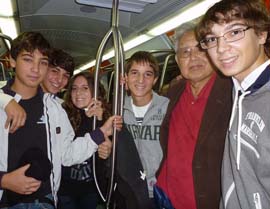
Italian high-school students on a crowded subway train in Rome. One of them wants to go to Harvard. 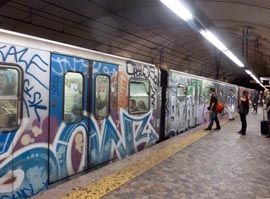
- Click here for the
the power-point presentation. This presentation is largely based on my
travel photo albums. You do not have to be a philosopher to follow the
logic.
- As for the scientific contents of my presentation. I can summarize them
in the following way.
- Kant. Many people wrote
about Kant's influence on Einstein. Since I cannot read Kant's long
sentences (sometimes, one sentence covering two pages), I went to to the
city where Kant spent the 80 years of his entire life. I then learned
how Kant was influenced by his environment. I finally became aware of
what Einstein inherited from Kant.
- Hegel. Einstein
observed that the energy-momentum relation takes different forms for slow and
fast (and massless) particles. From those two contrasting formulas, he
derived his energy momentum relation resulting in his celebrated E = mc2.
Einstein observed that Maxwell's electromagnetic theory and Newton's mechanics do not obey the same transformation law. He then developed a Lorentz-covariant mechanics.
Einstein was Hegeling while carrying out these two history-making projects. This leads us to a Hegelian view toward the history of physics. Click here for a story.
- I was Hegeling when I was writing my papers on the following projects.
- Massive and Massless Particles.
Their internal space-time symmetries are different. Can we find one
symmetry covering both?
- The quark and parton models are applicable to slow and fast protons respectively. They appear to be quite different. Is it possible to construct one picture applicable to both?
- Massive and Massless Particles.
Their internal space-time symmetries are different. Can we find one
symmetry covering both?
- This table summarizes what I said above.
Lorentz-covariant World Massive/Slow between Massless/Fast Energy
MomentumE=p2/2m Einstein's
E=(m2 + p2)1/2E=p Spin, Gauge,
HelicityS3
S1 S2Wigner's
Little GroupS3
Gauge Trans.Gell-Mann,
FeynmanQuark Model Lorentz-covariant
OscillatorsPartons - Rome page. If you do not want to think about
what I said above, fine. Go to this page and enjoy the city.
- Kant. Many people wrote
about Kant's influence on Einstein. Since I cannot read Kant's long
sentences (sometimes, one sentence covering two pages), I went to to the
city where Kant spent the 80 years of his entire life. I then learned
how Kant was influenced by his environment. I finally became aware of
what Einstein inherited from Kant.
copyright@2012 by Y. S. Kim, unless otherwise specified.
